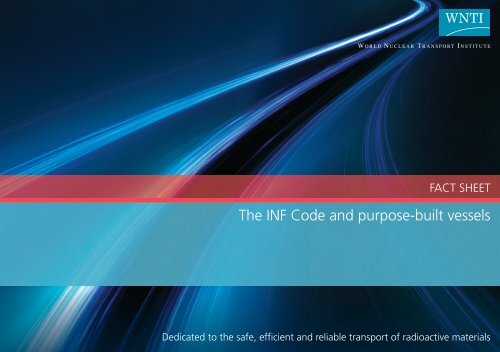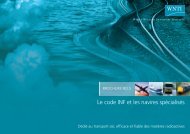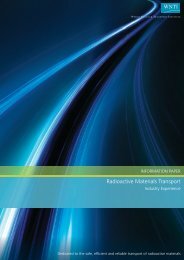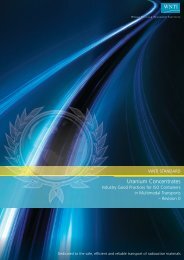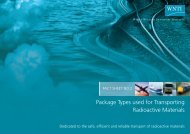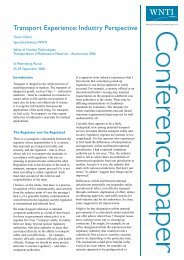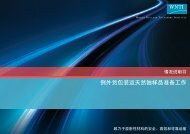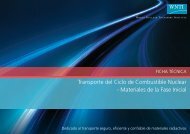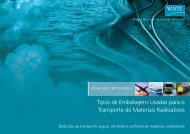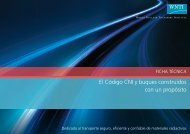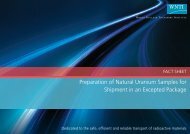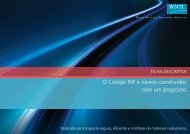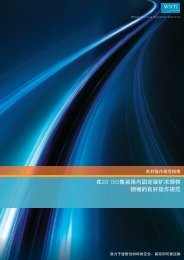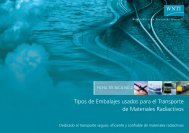The INF Code and purpose-built vessels - World Nuclear Transport ...
The INF Code and purpose-built vessels - World Nuclear Transport ...
The INF Code and purpose-built vessels - World Nuclear Transport ...
You also want an ePaper? Increase the reach of your titles
YUMPU automatically turns print PDFs into web optimized ePapers that Google loves.
WNTI<br />
W O R L D N U C L E A R T R A N S P O RT I N S T I T U T E<br />
FACT SHEET<br />
<strong>The</strong> <strong>INF</strong> <strong>Code</strong> <strong>and</strong> <strong>purpose</strong>-<strong>built</strong> <strong>vessels</strong><br />
Dedicated to the safe, efficient <strong>and</strong> reliable transport of radioactive materials
<strong>The</strong> <strong>INF</strong> <strong>Code</strong> <strong>and</strong> <strong>purpose</strong>-<strong>built</strong> <strong>vessels</strong><br />
1<br />
2<br />
3<br />
Introduction<br />
<strong>The</strong> principal regulations for radioactive transport<br />
are the International Atomic Energy Agency (IAEA)<br />
Regulations for the Safe <strong>Transport</strong> of Radioative Material<br />
which were first published in 1961. <strong>The</strong> Regulations<br />
have been reviewed regularly since then to keep pace<br />
with scientific <strong>and</strong> technological developments.<br />
<strong>The</strong> philosophy of the Regulations is that safety is<br />
ensured primarily by the package whatever the mode<br />
of transport. <strong>The</strong> regulations cover both normal <strong>and</strong><br />
potential accident conditions of transport to protect<br />
people, property <strong>and</strong> the environment against the<br />
effects of radiation.<br />
In 1993, the International Maritime Organization<br />
(IMO) introduced the voluntary <strong>Code</strong> for the Safe<br />
Carriage of Irradiated <strong>Nuclear</strong> Fuel, Plutonium <strong>and</strong><br />
High-Level Radioactive Wastes on Board Ships<br />
(<strong>INF</strong> <strong>Code</strong>), complementing the IAEA Regulations.<br />
This <strong>Code</strong> introduced recommendations for the design<br />
of ships transporting radioactive material <strong>and</strong> addressed<br />
such issues as stability after damage, fire protection, <strong>and</strong><br />
structural resistance. In January 2001, the <strong>INF</strong> <strong>Code</strong> was<br />
made m<strong>and</strong>atory <strong>and</strong> renamed the International <strong>Code</strong><br />
for the Safe Carriage of Packaged Irradiated <strong>Nuclear</strong> Fuel,<br />
Plutonium <strong>and</strong> High-Level Radioactive Waste on Board<br />
Ships. <strong>The</strong> <strong>INF</strong> <strong>Code</strong> is reviewed <strong>and</strong> ammended as<br />
required by the IMO.
Safety features of a <strong>purpose</strong>-<strong>built</strong> vessel<br />
Satellite navigation<br />
<strong>and</strong> communication<br />
Twin radars<br />
Reinforced hatch<br />
covers<br />
Emergency<br />
generator<br />
Salvage<br />
towing<br />
brackets<br />
Twin<br />
propellers<br />
<strong>and</strong> rudders<br />
Main<br />
electricity<br />
generators<br />
Independent<br />
engines <strong>and</strong><br />
gearboxes<br />
Collision<br />
reinforcement<br />
(20mm plate)<br />
Secondary<br />
collision<br />
bulkhead<br />
Forward<br />
generating<br />
room<br />
Bow<br />
thruster<br />
Primary<br />
collision<br />
bulkhead
<strong>The</strong> <strong>INF</strong> <strong>Code</strong><br />
Every aspect of ship construction, equipment,<br />
manning <strong>and</strong> operation must comply with domestic<br />
<strong>and</strong> international regulations. Domestic legislation is<br />
established from the many conventions <strong>and</strong> regulations<br />
agreed within the IMO, including the International<br />
Convention for the Safety of Life at Sea (SOLAS), the<br />
International Convention for the Prevention of Pollution<br />
from Ships (MARPOL) <strong>and</strong> the International Maritime<br />
Dangerous Goods <strong>Code</strong> (IMDG <strong>Code</strong>). <strong>The</strong>se regulations<br />
apply to all types of <strong>vessels</strong> <strong>and</strong> collectively they cover<br />
just about every aspect of ship design <strong>and</strong> operation.<br />
In addition, the <strong>INF</strong> <strong>Code</strong> imposes more stringent<br />
regulations for <strong>vessels</strong> carrying radioactive cargoes.<br />
Consequently, an <strong>INF</strong> vessel must comply with <strong>INF</strong>,<br />
IMDG, MARPOL <strong>and</strong> SOLAS requirements.<br />
SOLAS Convention<br />
SOLAS (SOLAS 74 Revised) sets st<strong>and</strong>ards for the safe<br />
operation of <strong>vessels</strong> <strong>and</strong> covers sub-division, stability,<br />
machinery, electrical installation, fire safety requirements,<br />
lifesaving, radio communication, safety of navigation,<br />
Table 1: Classes of <strong>INF</strong> Ship<br />
Class of ship<br />
Class <strong>INF</strong> 1 ship<br />
Class <strong>INF</strong> 2 ship<br />
Class <strong>INF</strong> 3 ship<br />
Criteria<br />
Ships which are<br />
Ships which are certified to carry irradiated<br />
Ships which are certified to carry<br />
certified to carry<br />
nuclear fuel or high-level radioactive wastes<br />
irradiated nuclear fuel or high-level<br />
materials with an<br />
with an aggregate radioactivity less than 2 x 10<br />
radioactive wastes, <strong>and</strong> ships which<br />
aggregate radioactivity<br />
6<br />
TBq <strong>and</strong> ships which are certified to carry<br />
are certified to carry plutonium with<br />
less than 4,000 TBq*<br />
plutonium with an aggregate radioactivity<br />
no restriction on the aggregate<br />
less than 2 x 10 5 TBq<br />
radioactivity of the materials<br />
* TBq = Tera-becquerels is the S1 unit of disintegration of a radioactive nuclei per second e.g. 9 x 10 12 Bq can be expressed as 9 TBq
Table 2: <strong>INF</strong> Ship Criteria<br />
Ship class<br />
Damage stability Fire protection Temperature<br />
control of<br />
cargo spaces<br />
Passenger<br />
ships*<br />
Cargo<br />
ships<br />
Passenger<br />
ships*<br />
Cargo<br />
ships<br />
Structural<br />
considerations<br />
Cargo<br />
securing<br />
arrangements<br />
Electrical<br />
supplies<br />
Radiological<br />
protection<br />
equipment<br />
Management,<br />
training <strong>and</strong><br />
shipboard<br />
emergency<br />
plan<br />
<strong>INF</strong> 1<br />
1<br />
1<br />
5<br />
5<br />
8 + 9 +10<br />
11<br />
12 +13<br />
14<br />
18<br />
19<br />
<strong>INF</strong> 2<br />
2<br />
3<br />
7<br />
7<br />
8 + 9 +10<br />
11<br />
12 +13<br />
15 + 16<br />
18<br />
19<br />
<strong>INF</strong> 3<br />
N/A<br />
4<br />
N/A<br />
6 + 7<br />
8 + 9 +10<br />
11<br />
12 +13<br />
15 + 16 + 17<br />
18<br />
19<br />
Note:<br />
Note:<br />
<strong>The</strong> numbers in the table correspond to the numbered paragraphs below.<br />
Points in brackets <strong>and</strong> italics are a brief description of the contents of the<br />
regulations referred to in the <strong>INF</strong> <strong>Code</strong>.<br />
N/A - <strong>INF</strong>3 is not allowed for passenger <strong>vessels</strong>.<br />
<strong>and</strong> carriage of dangerous goods. <strong>The</strong>re are additional<br />
requirements as prescribed in Table 2 concerning damage<br />
stability, fire protection, temperature control of cargo<br />
spaces, structural considerations, cargo securing<br />
arrangements, electrical supplies, radiological protection<br />
equipment, <strong>and</strong> management, training <strong>and</strong> shipboard<br />
emergency plans. <strong>The</strong> IMDG <strong>Code</strong> provisions also apply,<br />
which specify appropriate markings <strong>and</strong> labelling for<br />
packages <strong>and</strong> the requirements for securing the<br />
package to the vessel’s structure.<br />
* As defined in SOLAS 74, chapter 1, part A, regulation 2(f).<br />
(A ship is defined to be a passenger ship if it carries more than 12<br />
passengers. A cargo ship is any ship that is not a passenger ship.)<br />
MARPOL Convention<br />
MARPOL protects the marine environment from<br />
pollution by <strong>vessels</strong> <strong>and</strong> requires that a report be made<br />
to the nearest coastal state of any incident involving the<br />
loss or likely loss of any dangerous or polluting goods.<br />
Any serious threat to a vessel’s safety would also have<br />
to be reported under these regulations. International<br />
regulations apply exclusively to packages used for<br />
carrying radioactive materials. <strong>The</strong>se codes <strong>and</strong><br />
regulations are subject to continual review.
4<br />
5<br />
6<br />
Damage stability<br />
1. To the satisfaction of the relevant government<br />
bodies.<br />
2. Complying with part B, chapter II-1 of SOLAS 74.<br />
(Part B chapter II-I contains information regarding<br />
passenger ships <strong>and</strong> cargo ships regarding subdivision<br />
<strong>and</strong> stability. <strong>The</strong>se include items [but not limited to]<br />
permissible length of compartments, stability of<br />
passenger ships in damage condition, construction<br />
<strong>and</strong> initial testing of watertight bulkheads, watertight<br />
doors etc, bilge pumping arrangements, stability<br />
information <strong>and</strong> damage control.)<br />
3. Complying with part B-1, chapter II-1 of SOLAS 74.<br />
(Part B-1 contains regulations on the sub-division<br />
<strong>and</strong> damage stability of cargo ships, including [but<br />
not limited to] formulae to determine subdivision,<br />
stability information, openings in watertight<br />
bulkheads <strong>and</strong> external opening.)<br />
4. Complying with requirements for Type 1 ship<br />
survival capability <strong>and</strong> location of cargo spaces<br />
in chapter 2 of the International <strong>Code</strong> for the<br />
Construction <strong>and</strong> Equipment of Ships Carrying<br />
Dangerous Chemicals in Bulk (IBC <strong>Code</strong>) or,<br />
regardless of the length of the ship, the<br />
requirements in part B-1, chapter II-1 of SOLAS 74<br />
with subdivision index R<strong>INF</strong>. as given below:<br />
R<strong>INF</strong> = R + 0.2(1 – R)<br />
(R is the required subdivision index)<br />
Fire protection<br />
5. To the satisfaction of the Administration.<br />
6. Accommodation spaces, service spaces, control<br />
stations <strong>and</strong> machinery spaces of category A, as<br />
defined in regulation II-2/3.19 of SOLAS 74 shall<br />
be fitted either forward or aft of the cargo spaces,<br />
due regard being paid to the overall safety of<br />
the ship. (Category A space is one that contains<br />
internal combustion machinery used for main<br />
propulsion or for <strong>purpose</strong>s other than main<br />
propulsion where aggregate output is not less<br />
than 350kW or a space with any oil fired boiler<br />
or fuel unit.)
7<br />
8<br />
9<br />
7. Regardless of size, the vessel shall be fitted<br />
with the following systems <strong>and</strong> equipment:<br />
■ a water fire-extinguishing system complying<br />
with regulation II-2/4 of SOLAS 74 (covering<br />
fire pumps, fire mains, hydrants <strong>and</strong> hoses);<br />
■ a fixed fire-extinguishing system in the<br />
machinery spaces of category A, as defined<br />
above, complying with the requirements of<br />
regulation II-2/7 of SOLAS 74 (covering the types<br />
of extinguishing systems for spaces containing<br />
oil fired boilers, internal combustion machinery,<br />
steam turbines or enclosed steam engine, other<br />
machinery spaces, machinery spaces of category<br />
A in passenger ships <strong>and</strong> extinguishing systems<br />
not required by this chapter);<br />
■ fixed cargo space cooling arrangements,<br />
complying with the requirement of regulation<br />
II-2/54.2.1.3 of SOLAS 74 (requires ships to<br />
have a means of effectively cooling the<br />
under-deck cargo space by copious quantities<br />
of water, either by a fixed arrangement of<br />
spray nozzles or flooding the cargo spaces<br />
with water);<br />
■<br />
a fixed fire-detection <strong>and</strong> fire-alarm system,<br />
protecting the machinery spaces, accommodation<br />
<strong>and</strong> service spaces complying with the<br />
requirements of regulation II-2/13 of SOLAS 74<br />
(describes the design <strong>and</strong> installation<br />
requirements for fixed fire detection <strong>and</strong> fire<br />
alarm systems).<br />
Temperature control of cargo spaces<br />
8. Adequate ventilation or refrigeration of enclosed<br />
cargo spaces shall be provided so that the average<br />
ambient temperature within such spaces does not<br />
exceed 55˚C at any time.<br />
9. Ventilation or refrigeration systems serving cargo<br />
spaces intended for the transport of <strong>INF</strong> cargo shall<br />
be independent of those serving other spaces.<br />
10. Those items essential to operation, such as fans,<br />
compressors, heat exchangers <strong>and</strong> cooling water<br />
supply shall be provided in duplicate for each<br />
cargo space <strong>and</strong> spare parts shall be available<br />
to the satisfaction of the Administration.
10<br />
11<br />
12<br />
Structural considerations<br />
11. <strong>The</strong> structural strength of deck areas <strong>and</strong> support<br />
arrangements shall be sufficient to withst<strong>and</strong> the<br />
load, which is to be sustained.<br />
Cargo securing arrangements<br />
12. Adequate permanent securing devices shall be<br />
provided to prevent movement of the packages<br />
within the cargo spaces. In designing permanent<br />
devices, due consideration shall be given to the<br />
orientation of the packages <strong>and</strong> the following ship<br />
acceleration levels shall be taken into account:<br />
■<br />
■<br />
■<br />
■<br />
1.5g longitudinally;<br />
1.5g transversely;<br />
1.0g vertically up;<br />
2.0g vertically down;<br />
or alternatively, where packages are carried on the<br />
open deck or a vehicle deck, they shall be secured<br />
in accordance with the principles of safe stowage<br />
<strong>and</strong> securing of heavy unitised <strong>and</strong> wheel-based<br />
(rolling) cargo approved by the Administration,<br />
based on guidelines developed by the IMO in the<br />
<strong>Code</strong> of Safe Practice for Cargo Stowage <strong>and</strong><br />
Securing, taking into account the information<br />
given in the Guidelines for Securing Arrangements<br />
for the <strong>Transport</strong> of Road Vehicles on Ro-Ro Ships<br />
<strong>and</strong> the Provisions to be included in the Cargo<br />
Securing Manual to be carried on board ships.<br />
13. Collision chocks, where used, shall be so arranged<br />
that they will not interfere or prevent cooling air<br />
flow which is necessary under 8, 9 <strong>and</strong> 10.<br />
Electrical supplies<br />
14. To the satisfaction of the relevant government<br />
bodies.<br />
15. An alternative source of electrical power,<br />
complying with the requirements of the<br />
International Electrotechnical Commission<br />
(IEC), shall be provided so that damage<br />
involving the main supply would not also<br />
affect the alternative source.
16. <strong>The</strong> power available from the alternative source<br />
shall be sufficient to supply the following services<br />
for at least 36 hours:<br />
■ the equipment provided for the flooding <strong>and</strong><br />
cooling arrangements referred to above;<br />
■ all emergency services required by the<br />
Convention.<br />
17. <strong>The</strong> alternative source referred to in 15 shall be<br />
located outside the extent of any damage<br />
envisaged in 1, 2, 3 <strong>and</strong> 4.<br />
Radiological protection<br />
18. Depending upon the characteristics of the <strong>INF</strong><br />
cargo to be carried <strong>and</strong> upon the ships, additional<br />
arrangements or equipment for radiological<br />
protection shall, if necessary, be provided to the<br />
satisfaction of the relevant government bodies.<br />
Management, training <strong>and</strong> shipboard<br />
emergency plan<br />
19. Management, training <strong>and</strong> shipboard emergency<br />
plan for a ship carrying <strong>INF</strong> cargo shall be to the<br />
satisfaction of the Administration, taking into<br />
account developments in the IMO. Every ship<br />
carrying <strong>INF</strong> cargo shall carry a shipboard<br />
emergency plan.<br />
Survey <strong>and</strong> certification<br />
A ship that is certified for the carriage of <strong>INF</strong> cargoes is<br />
subject to inspections <strong>and</strong> surveys, as required in SOLAS<br />
74, chapter 1. Prior to transporting <strong>INF</strong> cargoes the ship<br />
must be internally surveyed, including a complete<br />
examination of its structure, equipment, fittings,<br />
arrangements <strong>and</strong> material. On passing an initial survey,<br />
an International Certificate of Fitness for the Carriage of<br />
<strong>INF</strong> Cargo is issued. This Certificate ceases to be valid<br />
if surveys have not been carried out or if the ship no<br />
longer complies with this <strong>Code</strong> when the Certificate<br />
has expired.
References<br />
<strong>The</strong>se excerpts have been taken with the permission of the International<br />
Maritime Organization (IMO), London from the IMO sales publication<br />
“<strong>Code</strong> for the Safe Carriage of Packaged Irradiated <strong>Nuclear</strong> Fuel, Plutonium<br />
<strong>and</strong> High-Level Radioactive Wastes in Flasks on Board Ships (<strong>INF</strong> <strong>Code</strong>) <strong>and</strong><br />
Guidelines for Developing Shipboard Emergency Plans for Ships Carrying<br />
Materials Subject to the <strong>INF</strong> <strong>Code</strong> – 1998 Edition”.<br />
<strong>The</strong> full text is available from the IMO Publishing Service, London<br />
Tel: +44 (020) 7735 7611<br />
Fax: +44 (020) 7587 3241<br />
e-mail: publications-sales@imo.org<br />
Photographs<br />
1 Purpose-<strong>built</strong> vessel<br />
2 Sea/rail transfer of test reactor fuel casks<br />
3 Unloading operations, Cherbourg, France<br />
4 <strong>INF</strong>2 Class ship<br />
5 Sea transport of vitrified high-level waste<br />
6 Sea transport of spent fuel<br />
7 Purpose-<strong>built</strong> vessel, Mutsu-Ogawara Port, Japan<br />
8 <strong>INF</strong>2 Class ship<br />
9 Unloading operations, Barrow Port, UK<br />
10 Sea/road unloading of plutonium from <strong>purpose</strong>-<strong>built</strong> vessel<br />
11 Unloading a cask of vitrified high-level waste,<br />
Mutsu-Ogawara Port, Japan<br />
12 <strong>Transport</strong> of spent fuel from Mutsu-Ogawara Port<br />
to reprocessing plant, Japan
WNTI<br />
W O R L D N U C L E A R T R A N S P O RT I N S T I T U T E<br />
Remo House<br />
310-312 Regent Street<br />
London W1B 3AX<br />
United Kingdom<br />
Tel: +44 (0)20 7580 1144<br />
Fax: +44 (0)20 7580 5365<br />
Web: www.wnti.co.uk<br />
Email: wnti@wnti.co.uk<br />
FS5_EN_MAR13_V2


